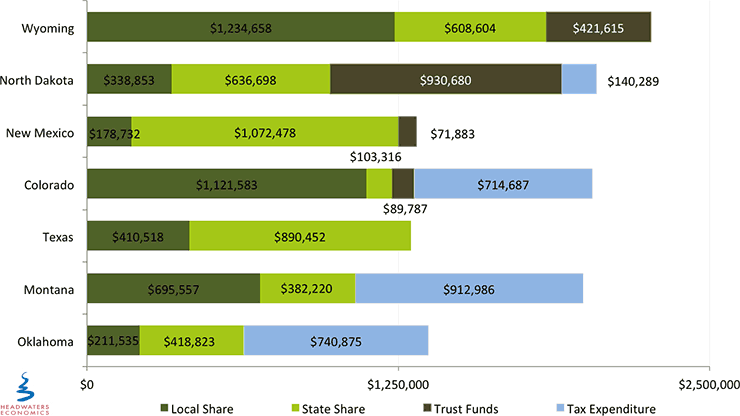Fiscal policy is important for local communities for several reasons. This analysis shows that many study communities are not receiving the resources necessary to manage impacts during the boom or to ensure resources are available after the boom. The New Mexico report is part of a larger series that looks at seven states: Colorado, Montana, New Mexico, North Dakota, Oklahoma, Texas, and Wyoming.
The focus on unconventional oil is important as horizontal drilling and hydraulic fracturing technologies have led a resurgence in oil production in the U.S. Unconventional oil plays require more wells to be drilled on a continuous basis to maintain production than comparable conventional oil fields. This expands potential employment, income, and tax benefits, but also heightens and extends public costs.
Mitigating the acute impacts associated with drilling activity and related population growth requires that revenue is available in the amount, time, and location necessary to build and maintain infrastructure and to provide services. In addition, managing volatility over time requires different fiscal strategies, including setting aside a portion of oil revenue in permanent funds.
Summary Findings
- New Mexico effective tax rate ranks fourth of the seven states we compare in this report. The state levies four different production taxes on oil production that add up to a total effective tax rate of 6.9 percent on unconventional oil production(see Figure 1 below).
- Local governments in New Mexico receive the lowest amount of tax revenue from unconventional oil production both in absolute terms and as a share of total production tax revenue compared to the other six states we include in this report (see Figure 2 below).
- Energy revenue is highly volatile and while the state’s investment in permanent funds helps to smooth this somewhat, local government budgets and services remain exposed to annual revenue volatility. The severance tax trust fund is used to make investments in statewide infrastructure, and some of these projects benefit communities where oil production takes place, but these communities remain dependent on local property taxes to fund basic services.
- Local government reliance on property taxes is problematic as revenue accrues to the taxing jurisdictions where production occurs, and not to adjacent cities and counties experiencing impacts. Property taxes also delay revenue collections by more than a year after initial oil production begins.
Figure 1. Comparison of Production Tax Revenue Collected from a Typical Unconventional Oil Well

Figure 2. Comparison of Distribution of Production Tax Revenue from a Typical Unconventional Oil Well

Background
Unconventional oil is extracted from tight shale formations using horizontal drilling and hydraulic fracturing technologies. The focus on unconventional oil is important as horizontal drilling and hydraulic fracturing technologies have led a resurgence in oil production in the U.S. Unconventional oil plays require more wells to be drilled on a continuous basis to maintain production than comparable conventional oil fields. This expands potential employment, income, and tax benefits, but also heightens and extends impacts on communities and public costs.
State and local governments levy different types of production taxes, at different rates, and offer a complex array of exemptions, deductions, and incentives. The various approaches to taxing oil and natural gas make comparisons between states difficult, although not impossible. This report applies each state’s fiscal policy, including production taxes and revenue distributions, to a typical new unconventional oil well over ten years of production. This allows for a comparison of how states tax oil extracted using unconventional technologies, and how this revenue is distributed to communities over time.
To provide a simple framework for the comparison, we assess state production tax policies on four criteria: the amount, time, location, and predictability of revenue distributions to local governments where extraction and associated impacts occur. We also provide a summary of the methods and data used to compare state fiscal policies.
The various approaches to taxing oil make comparisons between states difficult, although not impossible. To compare states, we apply each state’s fiscal policy, including production taxes and revenue distributions, to a typical unconventional oil well. This allows for a comparison of how states tax oil extracted using unconventional technologies, and how this revenue is distributed to communities.
We hope these data and resources will be useful to states and communities with unconventional oil development that are trying to mitigate the short-term impacts of oil extraction while making investments in long-term economic development opportunities.




